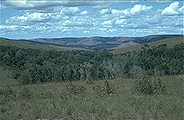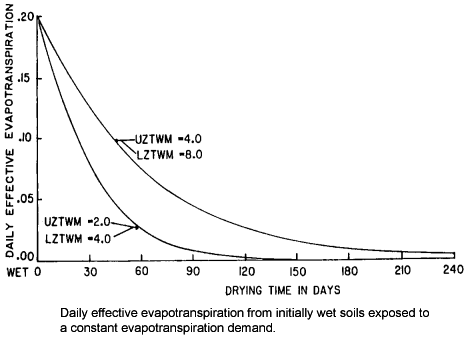
Evaporation and evapotranspiration
 Evaporation from the area covered by surface water or phreatophyte vegetation is computed at the potential rate.
Evaporation from the area covered by surface water or phreatophyte vegetation is computed at the potential rate.
( A phreatophyte is a plant whose roots generally extend downward to the water table and it customarily feeds on the capillary fringe. )
Over other portions of the soil mantle, evapotranspiration use varies with both evapotransporation demand and the volume and distribution of tension water storage.
As the soil mantle dries from evapotranspiration, moisture is withdrawn from the Upper Zone Tension Water storage at a rate determined by the potential evapotranspiration unmet by the upper zone times the ratio of the Lower Zone Tension Water contents to total tension water capacity.
If evapotranspiration should occur at such a rate that the ratio of contents-to-capacity for available free water exceeds the ratio of contents-to-capacity of tension water, then free water is considered to proportionally resupply
the tension water and the relative loadings are balanced in order to maintain a moisture profile that is logically consistent.
Depending upon basin conditions, some fraction of the Lower Zone Free Water is considered to be below the root zone and, therefore, unavailable for such transfers.

End of 


 Evaporation from the area covered by surface water or phreatophyte vegetation is computed at the potential rate.
Evaporation from the area covered by surface water or phreatophyte vegetation is computed at the potential rate.


